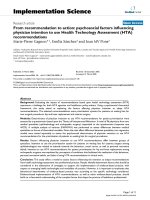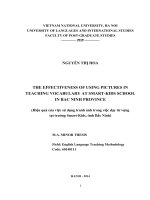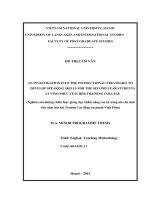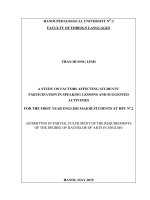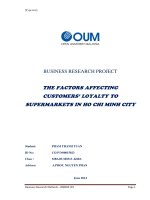Study the factors affecting the intention to use the training management software at Vinh Phuc colleges in Vinh Phuc Province, Viet Nam
Bạn đang xem bản rút gọn của tài liệu. Xem và tải ngay bản đầy đủ của tài liệu tại đây (846.18 KB, 68 trang )
MM
Shu-Te University
College of Informatics
Graduate School of Information Management
Master
Study the factors affecting the intention to use the training
management software at Vinh Phuc colleges in
Vinh Phuc Province, Viet Nam
Student: Nguyen Thi Thom
Adviser: Dr. Tsu-I Peng
Dr. Nguyen Huu Chau
March, 2013
- i -
Shu-Te University
Department of
Information
Management
Thesis
Study the factors affecting the intention to use the
training management software at Vinh Phuc colleges in
Vinh Phuc Province, Viet Nam
Nguyen Thi Thom
March, 2013
- ii -
Study the factors affecting the intention to use the training management
software at Vinh Phuc colleges in Vinh Phuc Province, Viet Nam
Student: Nguyen Thi Thom
Adviser: Dr. Tsu-I Peng, Dr. Nguyen Huu Chau
A Thesis
Submitted to the
Graduate School of Information Management
College of Informatics
Shu-Te University
In Partial Fulfillment of the Requirements
For the Degree of
Master of Science in
Information Management
March, 2013
- iii -
樹德科技大學碩士班研究生
Graduate Student of Shu-Te University
指導研授推薦書
Recommendation Letter from Thesis Adviser
本校資訊管理研究所 君
所提之論文係由本人指導撰述,同意提付審研。
This Student, Nguyen Thi Thom, whose thesis entitled
“Study the factors affecting the intention to use the training
management software at Vinh Phuc colleges in Vinh Phuc
Province, Viet Nam”, is under my advisory and agree to
submit for examination.
主要指導研授
Adviser
:
共同指導研授
Co-Adviser
:
年/Year 月/Month 日/Day
- iv -
樹德科技大學碩士班研究生
Graduate Student of Shu-Te University
學位考試審定書
Qualification Form of Master Degree
100 學年度第 2 學期
_________研究所 君所提之論文
題目:_____________________________________________________________________
經本學位考試委員會審議,認研符合碩士資格標準。
Student Name:Nguyen Thi Thom
Thesis Title:“Study the factors affecting the intention to use the
training management software at Vinh Phuc colleges in Vinh
Phuc Province, Viet Nam”
This is to certify that the thesis submitted by the student named
above in March, 2013. It is qualified and approved by the Thesis
Examination Committee.
召集人
Chair, Thesis Committee
:
委 員
Committee Member
:
- v -
委 員
Committee Member
:
主要指導研授
Adviser Committee
Member
:
共同指導研授
Co-Adviser Committee
Member
:
系所主管
Director of Department
:
年/Year 月/Month 日/Day
- vi -
Department of Information Management, Shu-Te University
Study the factors affecting the intention to use the training
management software at Vinh Phuc colleges in Vinh Phuc
Province, Viet Nam
Student: Nguyen Thi Thom
Adviser: Dr. Tsu-I Peng
Co-adviser: Dr. Nguyen Huu Chau
ABSTRACT
The research has been implemented with the following aims: Finding
solutions to encourage senior executives and employees to improve their
knowledge of information technology, using application of information
technology in their work actively and promoting the effective application of
information technology in the school and contribute to improving the quality of
training in Vinh Phuc province.
EduMan software could be applied for training management for secondary
professional, colleges, universities, vocational colleges, primary vocational both
formal and informal. Besides, this software allows training management for
short-term classes with comprehensive management functions in training area.
EduMan has been built based on current regulations on training management of
Ministry of Training and Education and Ministry of Social and Labor.
This study has used technology acceptance model TAM to measure
variables User training, Perceived ease of use, Perceived usefulness that have
- vii -
influence on the intention of use of training management software Eduman.
Based on 200 qualified questionnaires, study result shows that 5 hypothesis in
this study are accepted by respondents at an average level. Therefore, it is
recommended that software should be innovated, user training quality should be
enhanced regarding to the intention of use of training management software
Eduman at 5 colleges in Vinh Phuc province.
Keywords: Technology Acceptance Model, Eduman software, Vinh Phuc
College
- viii -
Acknowledgments
Any attempt at any level cannot be satisfactorily completed without the
support and guidance of learned people. I would like to express my immense
gratitude to Dr. Loc Thi My Nguyen, Dr. Pi-Yun Chen, Dr. Tsu-I Peng and Mr.
Chau Huu Nguyen for their constant support and motivation that has encouraged
me to come up with this project.
I am also thankful to all other members of the following universities: Vinh
Phuc teacher training college, Viet Duc college; Economics college; Industrial
college, Transportation technology university for having rendered their whole
hearted support at all times for the successful completion of this project.
- ix -
Table of Contents
ABSTRACT vii
Acknowledgments ix
Table of Contents x
List of Table xii
List of Figures xiii
Abbreviations xiv
Chapter 1: Introduction 1
1.1.Research background 1
1.2.Research Motive 4
1.3.Research Purpose 4
1.4.Research questions 5
1.5.Research Procedure 5
Chapter 2: Literature review 6
2.1.Eduman software introduction 6
2.2.TAM model 14
Chapter 3: Research Method 20
3.1.Research Model 20
3.2.The factors of model 20
3.3.Research Hypothesis 25
3.4.Sampling methods 26
3.5.Questionaire design 27
3.6.Measurement of Variables 27
3.7.Data collection 28
Chapter 4: Data Analysis 30
4.1.Sample characteristic 30
4.2.Desctiptive statistics 31
4.3.Factor Analysis 32
- x -
4.4.Assess the reliability of the scale 34
4.5.Correlation coefficient among factors 38
4.6.Hypothesis Test 39
4.7.Regression 41
Chapter 5: Conclusion 46
5.1.Findings and Contributions 46
5.2.Suggestions 47
5.3.Limitations 48
Reference 49
Appendix: Questionnnaire 51
- xi -
List of Table
Table 1: Revised 6 items sacle for PU worded towards Chart-Master 15
Table 2: Revised 6 items sacle for PEOU worded towards Chart-Master 15
Table 3: Sample characteristic 30
Table 4: Descriptive Statistics 31
Table 5: KMO and Bartlett's Test 32
Table 6: Total Variance Explained 33
Table 7: Rotated Component Matrixa 34
Table 8: Reliability of TR, EU, PU and IU 37
Table 9: Correlations 38
Table 10: regression analysis result 43
Table 11: The summary table of testing results 45
- xii -
List of Figures
Figure 1: New relationship formulation in TAM 16
Figure 2: Final version of TAM 17
Figure 3: Research model 20
- xiii -
Abbreviations
TAM Technology acceptance model
TR
User training
PU
Perceived usefulness
PEOU
Perceived ease of use
IU
Intention to use
- xiv -
Chapter 1: Introduction
1.1. Research background
1.1.1 General informations
The 21st century is the century of the development of knowledge economy
associated with the development of information technology and communications in
which there has been an outbreak and several major advances of technology in many
fields, with new applications, services and products. The material and spiritual products
of that technology have become part of daily life, quickly taking people from the
industrial society to the information society, from the industrial economy to the
knowledge economy in which competitiveness mainly depends on creativity and the
capacity to collect and process information.
Vietnam is in the stage of integrating with the countries in the region and in the
world, facing globalization in the world economy. It’s essential to promote the
development of information technology with the aim of building a firm foundation for
an advanced information infrastructure. In recent years, the Vietnamese Party and
Government have paid much attention to the application of information technology in
management and have issued many related documents.
In the changing information revolution, the Vietnamese Communist Party and
Vietnamese Government have realized that information technology is one of the most
important forces of development. Instruction 58/CT-TW October 17th (2000) by the
Politburo show that “Application and Development of Information Technology are prior
tasks in economic and social development, also are main facilities to meet the demands
of implementing the successful industrialization and modernization” [1]
On February 17th, 2002 the Prime Minister signed Decision No. 95/2002/QD-
TTg approving the master plan on the application of Information Technology in
Vietnam by 2005 with the main task: “Application of information technology in the
activities of the Party, State, social and political organizations and spearhead economic
sectors plays the leading role in the national economy of the center, Ho Chi Minh city,
Hanoi city to reach the advanced level in the region.” [2]
On September 30th 2008, The Ministry of Education and Training issued the
Instructive No 55/2008-BGDDT-CNTT on enhancing teaching, training and applying of
information technology in education sector from 2008 to 2010. “Information technology
is a powerful tool helping to reform teaching methods and education management to
improve the efficiency and teaching quality. Developing Human Resource in
Information Technology and applying Information Technology in education are major
tasks in Education and Training” [3]
In the instructive, the Minister requires all levels of authorities, and education
establishments to:
- Raise the awareness of importance and role of information technology and
promote information technology application in education and training during the school
year 2008-2009 which is called “the school year of promoting information technology
application”, and to create breakthrough in information technology application and
premise of development of information technology in the next years;
- Set up a system of organizations responsible for information technology in
education;
- Develop services of education information on the internet;
- Improve information technology application in order to innovate teaching and
learning methods at every level of education;
- Enhance information technology applications in leading and managing
education;
- Improve teaching and training and research in information technology;
- Promote international co-operations and socialization.
As for Vinh Phuc School of Arts and Culture, the tasks of the school is to train
senior executives and staff with good quality and professional skills to provide a well-
trained labor force for the sector. Therefore the school has to complete its tasks well.
One of the most important factors which helps the school to fulfill its tasks successfully
is to improve information technology application in education management. For the last
few years, the school has invested in infrastructure and computer systems. The number
of computer users is increasing. However, the current applications are simple such as:
searching information, processing words. Applications to improve the management
functions, and the training quality are limited and not up to the potential and ability of
humans.
From the above reasons, in my thesis, I choose the topic: Study the factors
affecting the intention to use the training management software at Vinh Phuc colleges in
Vinh Phuc Province, Viet Nam
1.2.1 Introduction of Vinh Phuc College
Being established in 1964 and after nearly 50 years of development, Vinh Phuc
College already trained 47 courses of student and had more than 10,000 graduated
students. Derived from the actual needs of the society and province from 2005 to now,
the training system of the school has been changed continuously.
With nearly 50 years of tradition in building and developing, Vinh Phuc College
aims to train and improve staff specialized in the field of Culture, Arts and Tourism,
Management and Organizations, joint training with other universities, colleges in field
of Music, Arts, cultural and library management to meet the needs of learners and
society.
With the reputation of reliable and experienced education and training,
especially in some key sectors such as the field of Music, Art, Dance, Cultural
Management, Library, and Tourisim the school has a team of young, dynamic,
enthusiastic, responsible, qualified staff to meet the increasing requirements of the
school. Moreover, current intermediate training program of the school meets
professional standards and the quality of school education in the recent years
experienced a significant positive change, especially the percentage of students
employed after graduation has increased. There have been many students graduated
from the school and have important positions in many different industries in and outside
the province.
Along with the expansion of training system is diversifying the types of training,
the school has recently affiliated with many other universities in the country. In addition
to formal training, the school also opened in-service training courses, regular training
courses, and short-term training courses The number of admissions is based on local
needs and targets of Vinh Phuc province.
ORGANIZATIONAL STRUCTURE
- Managing board: 1 headmaster, 2 deputy heads.
- Practical Center – Art Performance
- Staff organization department
- Administrative department
- Finance department
- Training and Scientific Research department
- Student cooperation department
PROFESSIONAL DEPARTMENTS
- Faculty of Cultural Affairs
- Faculty of Music
- Faculty of Fine Arts
- Faculty of Tourism
UNION ORGANIZATIONS
- Party Cell
- Union
- Communist Youth Union
1.2. Research Motive
- Improve training quality and brand of the school by applying information
technology to all school activities
- Find solutions to promote the senior executives and employees to apply
information technology
1.3. Research Purpose
The research has been implemented for following objectives:
- Find solutions to encourage senior executives and employees to improve their
knowledge of information technology, use application of information technology in
their work actively .
- Promote the effective application of information technology in the school and
contribute to improving the quality of training.
1.4. Research questions
- What are the factors affecting of intention to use the the training management
software of senior executives and employees?
- What are the solutions to be proposed for improving the effective of the
training management software?
- What regulations will be made to apply the the training management software
successfully?
1.5. Research Procedure
Chapter 2: Literature review
2.1. Eduman software introduction
2.1.1. Overview
Eduman software can be applied for Training Management for Intermediate
Professional schools, Colleges, Universities, Vocational Colleges, Vocational
Intermediate schools, vocational training including formal and non-formal one. Besides,
the software is also used in management training for short-term special classes
Eduman uses Unicode code table which has user-friendly interface, reports with
nice-display which are automatically designed, and ease to convert data to other
environments such as Acrobat Reader (*. Pdf), MS Excel (*. xls), MS Access (*. mdb),
Web page (*. html), Picture files (*. tif) and vice versa.
Eduman was designed based on the current training management regulations of
the Ministry of Education & Training and the Ministry of Labor, War Invalids and
Social Affairs.
Eduman uses centralized databased management system, allowing users to
access to many levels such as: staff in Training department, in student management
department, in Finance department, in training bureau, and leaders. In particular, each
subject teacher is also allowed to use it to enter scores of subjects.
Data is processed through the following functions: Filtering data (similar to the
Auto Filter function in Microsoft Excel), sorting data with multiple sorting criteria,
printing the report forms from data obtained, Searching data
2.1.2. Main functions of Eduman software
Recruitment, admission, classification
Admission is based on the total points of all subjects plus priority points for
areas and special subjects plus bonus points.
After admission, this software will allow classification based on the principle of
uniformity on gender, test results, name, and place of birth… between the classes.
Besides, it also allows doing admission and classification in many courses.
Enrollment data can be imported from the Admissions software of the Ministry
of Education and Training or make a copy and paste directly from Microsoft Excel.
Student management
Storing documents of students includes information such as full name, date of
birth, place of birth, ethnic group, date of joining the Communist Young Union, Date of
joining Party, educational level, phone number, address, etc. In addition, this software
also stores the learning process, family relationships, and images of students.
Allowing management of the whole process that students temporarily reside
during the school time including: date of registration, form of temporary residence
(residence, at home, house renting), address, phone number, host name, reward, and
discipline,
Allows filtering (filter) data on the profile of students as required in order to
facilitate the search, statistics and reports.
Searching and doing statistics on information in a variety of different conditions,
printing resumes, printing the student registration book.
Managing ethics score (conduct) and training scores of each student in every
semester, every school year, and the entire course.
Rewarding and disciplining management of students monthly in order to easily
do the statistics when necessary.
Managing the position of students in class.
Managing Training program
Managing the frame of training program for each field of study.
Practical training program can be built for each class based on the frame of
training program of the appropriate field of study.
Managing timetable and teaching progress
Updating weekly timetable on the basis of a warning of identical teaching hours
of teachers and classrooms, viewing and printing timetable for classes and teachers.
Managing teaching schedule for each subject in the class like the total number of
classes being taught per week and the rest… Teaching progress is based on the weekly
schedule of classes.
On the basis of the schedule has been set, the system allows checking
attendances every week, according to each subject and the corresponding class.
Training management
Training management is based on the classification of courses, majors and
classes.
Allowing holding semester exam, graduation exam by dividing test rooms,
making order number on the name list of candidates, printing test list and entering mark
according to test room.
Printing student ID, study certificate, temporary graduate certificate and such
kinds of list as test list, scoring list, list view, Specifically it allowed to print the list
of classes by setting filter conditions, adjusting the order of the displaying columns,
Considering eligibility for doing exam to finish the subject, to pass the course
after every school year, to do the graduation exam, to graduate, and then printing the list
of eligibility, ineligibility, reserved list.
Processing reserving documents and learning outcomes, study abandonment,
class transfer, dividing student into many classes
Assigning teaching for teachers, allowing teachers to enter scores of the courses
that they undertake.
Printing registration book for students including curriculum vitae, academic
performance each year, the results of the graduation exam, graduation results; Entering
the information and printing the graduation diploma.
Making statistic of classes of teaching theory and practice according to every
training system of each semester every year.
Score management
Allowing entering scores according to many coefficient columns including:
Entering scores according to the coefficient columns 1, 2, (the number of
coefficient columns for each subject coefficients of each student in the class may vary)
Entering scores according to in the free coefficient which is defined by user
Putting heading for each subject (or each test room), entering scores according to
the heading.
Printing many types of transcript such as transcript for each subject, for each
semester, for each school year, transcript for assessing scholarship for a semester or a
school year, the transcript for the whole course, and the graduation transcript.



